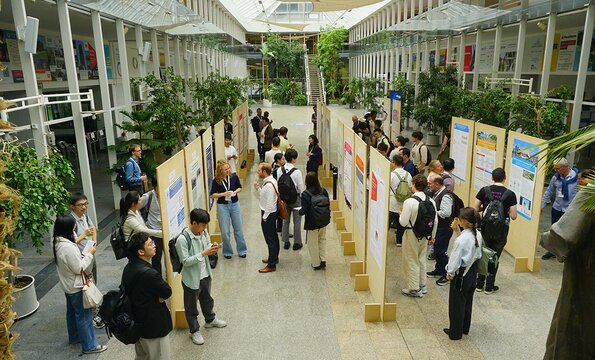
How does a crowd of people react under stress? Can an evacuation be simulated? And what can ordinary walking reveal about us? These and other questions were addressed at the international scientific conference Pedestrian and Evacuation Dynamics 2025 (PED 2025), which brought together 137 participants from all over the world. They are engaged in interdisciplinary research on human movement – from physical modeling and simulations, through the use of artificial intelligence and machine learning, psychology, or virtual reality, to applications in fire safety and urban planning. The event took place on September 9–12, 2025, at the Faculty of Information Technology (FIT CTU) and the Faculty of Civil Engineering (FCE CTU) in Prague.
The PED conference has been held regularly since 2001, and this year, for the very first time, it came to Prague. Its goal was to share the latest findings in the study of human movement, especially in crisis situations – such as fires, evacuations, or overcrowded spaces. However, research is increasingly focusing also on non-crisis movement scenarios, such as large-scale events with high crowd density – for example, navigation through train stations or festivals, the running of the bulls in Pamplona, or Ramadan celebrations in Mecca.
“PED is truly an interdisciplinary conference, bringing together topics from physical modeling, computer science, psychology, experimental research, machine learning, and more – all with the same goal: to describe and model pedestrian behavior. From this perspective, I am glad that we managed to organize the 12th edition of this conference at CTU in Prague, within the framework of interfaculty cooperation between our university’s oldest and youngest faculties. A great effort also went into preparing a workshop for PhD students, ensuring it was a truly hands-on seminar and not just a sequence of lectures. I believe participants appreciated being actively involved in all phases of data collection during the evacuation experiment,” said Assoc. Prof. Pavel Hrabák, Ph.D., from the Department of Applied Mathematics at FIT CTU and one of the event’s organizers.
The scientific program was opened by Maik Boltes from the German Forschungszentrum Jülich, who addressed the topic of empiricism – the collection of data from pedestrian experiments – which is key to creating realistic simulation models. On the following day, He Wang from University College London sparked discussion about how, and whether at all, artificial intelligence and machine learning can help predict human behavior in crowds. The final keynote lecture was delivered by Simo Hostikka from Aalto University, who emphasized the need to link fire modeling algorithms with evacuation simulations. He reminded participants that evacuation in the context of fire safety was the original motivation for the creation of this research field.
Ing. Hana Najmanová, Ph.D., who co-led the event on behalf of FCE CTU, added: “At FCE CTU we have long been dedicated to fire safety, and evacuation is one of our key topics. Hosting PED 2025 provided us with a unique opportunity to welcome leading experts from around the world and to engage in interdisciplinary discussions directly on our campus. This is extremely valuable, because it is precisely mutual collaboration that enables us to develop solutions with real application potential for the design of safe buildings and public spaces.”
A particularly well-received part of the program was the hands-on workshop focused on collecting data from pedestrian movement experiments. The workshop was organized by the conference team in cooperation with the Image Processing Laboratory at FIT CTU and the Pedestrian Dynamics – Empiricism division of Forschungszentrum Jülich, represented by keynote speaker Maik Boltes.
The 35 workshop participants (mostly PhD students, who were the primary target group) had the opportunity to practically experience the entire process of a pedestrian movement experiment – from preparation, through data collection, to extracting useful information from recorded videos of the experiment, which are then used for further analysis and processing. During the workshop, a real-life experiment was conducted with the participants themselves, who later in the FIT CTU laboratories practiced how to obtain concrete movement data from video recordings for further scientific use.
The program also included the traditional poster session, showcasing an overview of the latest research projects from around the globe. A visually engaging part of the event was the exhibition booth of the conference’s main sponsor – Thunderhead Engineering – which presented its tools for simulating evacuations and crisis scenarios.




